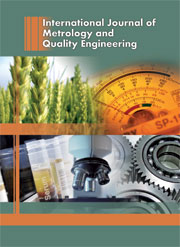Article contents
ASME B89.4.19 standard for laser tracker verification –experiences and optimisations
Published online by Cambridge University Press: 14 November 2012
Abstract
Laser trackers are becoming the tool of choice for large volume dimensional metrologyapplications such as the measurement of aerospace assemblies, power plant structures,civil engineering structures and terrestrial transportation vehicles. A laser tracker is aportable coordinate measuring system that tracks a moving target reflector and measuresthe position of the target in spherical coordinates (r,θ, φ). The metrological performance of a laser trackeris influenced by many factors including: compensation for atmospheric effects, thermalexpansion of the instrument and its mount, thermal distortion of the workpiece or artefactbeing measured, the wavelength of the laser radiation, the internal alignment of thegimbal axes and the linearity and alignment of the internal angular measuring scales. Themost important of these potential error sources, which fundamentally limit the achievableuncertainty, are the internal mechanical and optical alignments and the quality andalignment of the angular scales. Several national and international standards exist or arein the process of being developed for performance verification of laser trackers. ASMEB89.4.19-2006 is one of the established standards used to verify the performance of lasertrackers. The main test relies on measuring a known reference length in a variety ofconfigurations and ranges and comparison of the observed error (laser tracker measuredlength minus reference length) with the specified maximum permissible error (MPE) definedby the manufacturer. The establishment of an ASME B89.4.19 laser tracker verificationfacility at NPL is introduced. We highlight the importance of tracker verification anddiscuss the error sources, which contribute to the tracker measurement uncertainty. Someinitial results obtained using this new facility are presented.
Keywords
Information
- Type
- Research Article
- Information
- International Journal of Metrology and Quality Engineering , Volume 3 , Issue 2 , 2012 , pp. 89 - 95
- Copyright
- © EDP Sciences 2012
References
- 12
- Cited by

